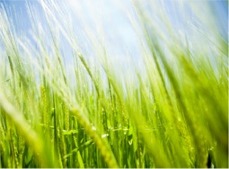Barley
 Like all cereals, barley has been progressively bred and developed from former wild grasses. In this case, the process has been going on since Neolithic times around 10,000 years BC. There is evidence to suggest that not only was barley a staple for the early farmers in the Middle East, but they also used it to make beer. Barley seems to have grown for millenia throughout the Northern Hemisphere from Korea and Tibet to Europe and the Near East.
Like all cereals, barley has been progressively bred and developed from former wild grasses. In this case, the process has been going on since Neolithic times around 10,000 years BC. There is evidence to suggest that not only was barley a staple for the early farmers in the Middle East, but they also used it to make beer. Barley seems to have grown for millenia throughout the Northern Hemisphere from Korea and Tibet to Europe and the Near East.
There are several separate barley species and many varieties. "Two-Row" species represent the majority, "Six-Row" species result from a genetic mutation and an ancient species known as "Naked Barley" is so-called because the seed is hull-less, making it easier to process in the food industry. All are grown in the UK, but the latter two supply only niche markets.
The main uses for the "Two-Row" species are for animal feed and for malting purposes and many varieties have been developed to amplify desirable traits; particularly yields. The modern barley is expected to produce 8-9 tonnes per hectare; less than wheat, but cheaper to grow. Roughly half of UK barley is winter sown, giving greater yield but poorer quality and most goes for animal feed. In less temperate countries it is only possible to grow spring varieties because barley cannot tolerate cold winters. Spring sown varieties are mainly aimed at the Malting barley market and attract a premium. An advantage for the grower is that malting barleys need lower levels of protein to assist fermentation and therefore require less nitrogen fertiliser.
Malting barley is used in beer and whisky making and also in a variety of food products. In recent years an old species, Maris Otter, has been revived and refined by H Banham & Robin Appel Ltd. primarily for the real ale market and now commands a premium world-wide.
It is high time that barley was also recognised as a health food, because, when grown on mineral-rich soils, it produces high levels of Beta-Glucans (dietary fibre) and selenium, phosphorus, manganese and copper. It can be made into bread, biscuits and breakfast cereals and has the capacity to reduce the incidence of many chronic diseases in the human population, such as heart disease, cancer and diabetes.
The Dressing Process
Field Science tailored mineral dressings are always based on detailed soil analysis of the field to be treated. A member of our technical team will visit your farm to discuss and identify where we can help. Soil samples are then taken and the tailored dressings are based on the independent laboratory’s results.
The dressings are available in two concentrations:
1 Year Dressing is cheaper per acre and is essential if the soil is ploughed after harvest or if the soil is extremely sandy.
Full Dressing is formulated to last for 2 - 3 seasons from application (subject to nutrient retention qualities of the field). This dressing is cheaper in the long run given the longevity and the cost of application only once every 2 - 3 years but the soil must not be ploughed during this time. Min-tillage is perfectly acceptable.
The best time for application is just after emergence in the case of spring barley and February/March for winter sown barley. This avoids any particularly wet weather.
The application rate is usually 25kg per hectare (10kg/ac) and the most effective method of application is to use an electric spinner (slug-pelleter) on a quad bike. The dressings are packed in 25kg bags, clearly labelled with the farm details, field name, application rate and bag weight.
